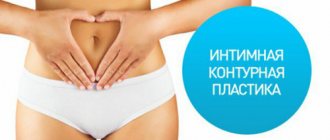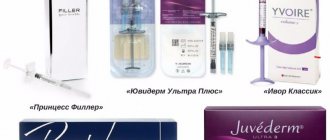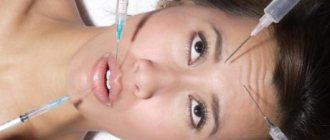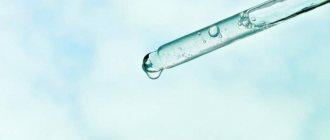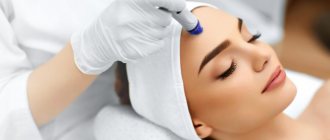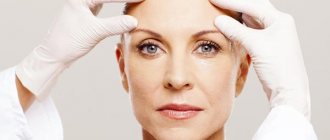What's happened
Correction of facial contours in cosmetology using contour plastic surgery involves the introduction of special compounds under the skin. When biosubstances penetrate into the epidermis and dermis, voids are filled and the natural restoration process is activated at the cellular level. Due to this, an increase in tightness, restoration of metabolism and faster tissue regeneration are achieved. The skin becomes tightened, facial contours become clearer.
Modern materials used during the procedure do not pose a danger to the human body and do not provoke the development of an allergic reaction. In addition, in most cases, the biogel takes root well and is not rejected. Thanks to the active components present in the composition, the production of natural collagen and elastin fibers is activated, and the overall condition of the skin improves.
Among the main advantages of such plastic surgery are low cost, versatility, safety, a short recovery period, a large selection of bio-compositions, and a minimum of complications.
Disadvantages include maintaining the results obtained for a short time, as well as the need to perform several procedures to achieve the desired effect.
Volume modeling – baked apples are canceled
Go over the skin with an eraser, like over a sheet of paper, erase fatigue, wrinkles, swollen ovals, all sorts of annoying troubles that treacherously reveal age, or even add several years. This is not science fiction - volumetric facial modeling restores youth and beauty in one procedure. There is no need to go under the plastic surgeon's knife. The role of the eraser is played by the filler, the artist is a cosmetologist with experience, sensitive hands, and impeccable aesthetic taste. How to get an appointment with someone like this - just come to our clinic.
Indications
Correction of facial contours and double chin without surgery is possible for people regardless of their age. Moreover, thanks to such manipulation, problems such as tightening, leveling the relief, and restoring symmetry can be solved.
On this topic
- Contour plastic
Forehead contouring
- Olga Aleksandrovna Kalinina
- October 18, 2020
A cosmetic procedure is prescribed if there are problems such as:
- development of ptosis at the initial stage;
- formation of small wrinkles ;
- asymmetrical features;
- weakly defined cheekbones ;
- blurred contours .
Most often, facial oval correction with fillers is recommended for people aged 30-60 years. The method can be performed in combination with other injection procedures. In terms of effectiveness, it is in no way inferior to the results after a lift using surgical intervention.
Lip correction
One of the popular cosmetic procedures is lip contouring. Cosmetologists do it when clients seek help in solving problems of smoothing out the contour of the lips or to add volume to the lips.
You can find out how much such a procedure will cost and how many fillers will be needed to achieve the result at your first consultation with a cosmetologist.
The use of hyaluronic acid will give your lips volume and expressiveness.
Most often, cosmetologists conduct the first consultation free of charge. Therefore, it is enough to ask several clinics about the conditions and choose the appropriate ones.
The average cost of lip correction is about $300.
The peculiarity of the introduction of hyaluronic acid into the lip area is the pain of this procedure, despite local anesthesia.
By the way, it is pain relief with hyaluronic acid injections that is the subject of controversy among doctors themselves. Professionals recommend doing injections without anesthesia.
This is explained by the fact that during the injection of filler without anesthesia, the cosmetologist can monitor the patient’s reaction, and this will help avoid cases of injury to nerves or blood vessels.
Therefore, during the consultation, it makes sense to discuss with the cosmetologist the possibility of performing facial contouring without anesthesia. Answering the questions will make it possible not only to determine an acceptable way to perform the procedure, but will also help to determine the level of professionalism of the cosmetologist.
Contraindications
Despite the safety and minimally invasiveness of the method, there are certain limitations to its use. Thus, the following pathological conditions are considered the main contraindications:
- immune diseases ;
- herpetic rashes;
- chronic diseases that occur in an acute form;
- ARVI and acute respiratory infections;
- predisposition to the formation of keloid- type scars;
- clotting disorder .
Correction is also not allowed during pregnancy and breastfeeding.
Types of contour plastic surgery
Reinforcement
Photo: Pexels.com
This is a non-surgical facial treatment that produces a circular tightening effect.
Advantages:
- The result is immediately visible
- Performed under local anesthesia
- The procedure lasts no more than 40 minutes
- Does not require hospitalization
- Leaves no scars
- Quick skin recovery after the procedure, no long recovery period required
Indications:
Recommendations for use include disruption of facial contours, drooping tissue of the cheekbones and cheeks, nasolabial folds, sagging skin on the chin, and the fight against age-related changes.
Lipofilling
Photo: Pexels.com
This is a technique for correcting age-related changes in the face and body contours, which involves transplanting the patient’s fat tissue from one area to another. Refers to plastic surgery. Due to the fact that no chemical additives are used, but natural fatty tissues are involved, the effect lasts for many years.
Indications:
- Elimination of nasolabial folds
- Correction of lip size and chin shape
- Breast augmentation
- Hand rejuvenation
- Changing the shape of the buttocks
- Facial injuries
Advantages:
- Has no age restrictions
- Suitable for both men and women
- Allows you to get rid of many cosmetic problems without using synthetic drugs
- The result lasts a long time
- Does not require hospitalization and long recovery. Rehabilitation takes place within a week.
The disadvantage of the procedure is that it involves surgical intervention. Therefore, pain and swelling are possible and anesthesia is required.
Beautyification
Photo: Pexels.com
A facial skin rejuvenation procedure that involves a set of measures for 3D modeling, volume restoration and rejuvenation. The effect is achieved after the first procedure and lasts for more than a year. Preparations based on botulinum toxin xeomin and hydroxyapatite, and hyaluronic acid fillers are used.
Beauty results:
- Elimination of wrinkles
- Restoring lost proportions
- Facelift
- Thread lifting
- Contour correction
- Rejuvenation of the neck and décolleté area
- Lip rejuvenation and modeling
Modeling facial features using fillers
For contouring, different types of fillers are used. The safest are fillers with a natural composition, for example, containing hyaluronic acid or collagen, polylactic acid, acrylic powder. They act from the inside, trigger regeneration and do not cause rejection. Such fillers are also called biocompatible due to their compatibility with the human body.
Synthetic fillers provide instant results and combat serious dermatological defects. However, they can provoke rejection, in which case they will have to be removed surgically. Contains artificial polymers.
Preparations of a semi-synthetic composition maintain elasticity, are well accepted by the body, but are quickly eliminated.
Contraindications:
- Pregnancy and lactation
- Herpes, infectious diseases
- Oncology and diabetes
- Poor blood clotting
- Tendency to scarring
- Open skin lesions (wounds, cuts, burns)
- Strong pigmentation
- Mental illness
- Previously used peeling or laser
- Presence of chronic or cardiovascular diseases
Advantages of contour plastic surgery:
- Fast recovery due to minor tissue damage
- Safety and painlessness of the procedure
- Gives a quick visual effect
- Rejuvenates the skin
- Fights wrinkles, models the oval of the face, creates additional volume
- Removes wrinkles, scars, pigmentation
- Increases lip volume
Minuses:
- Will not help solve serious age-related problems
- High price of drugs
- Performed only by an experienced cosmetologist
Fillers used
To perform contouring, the specialist uses various types of drugs, each of which has its own characteristic features.
Synthetic
The peculiarity of such fillers lies in the versatility of the components that are included in the composition. The product is based on silicone, paraffin or polyacrylamide. Their main property is that they are not able to be excreted from the human body naturally. This is precisely what explains their use in cases where a permanent effect is required.
Among the main disadvantages is the low level of bioinertness of the components, which often causes the development of side effects, for example, inflammation or allergies.
Biosynthetic
They are based on biological, chemically modified elements. These cocktails contain a high proportion of soluble collagen, polycaprolactone and hydroxyapatite. They may also contain synthetic components - carboxymethylcellulose, polymethyl methacrylates.
Thanks to natural components, natural cell regeneration processes are launched, and synthetic ones help fill voids and replenish the missing volume in tissues.
Biodegradable
Such drugs have a temporary effect and can be completely eliminated from the human body. The main advantage of these compounds is that they are almost never accompanied by complications. The main components of fillers are lactic and hyaluronic acid, collagen.
The cosmetologist decides which drug to choose in a particular case. At the same time, he takes into account the general condition of the skin in the problem area, existing limitations, and the patient’s wishes.
Preparation
Before performing filler correction, the doctor must examine the client, ask him about previously performed cosmetic procedures, and about the likelihood of developing allergies to certain drugs. It is also important to assess your overall health.
On this topic
- Contour plastic
Consequences of fillers
- Olga Aleksandrovna Kalinina
- October 18, 2020
Laboratory testing may also be required, which includes:
- general blood analysis;
- coagulogram;
- biochemistry;
- test to assess the level of clotting ;
- on the tendency to exhibit an allergic reaction.
If there are no restrictions on the manipulation, the cosmetologist, together with the patient, determines the date and time of the correction and gives subsequent recommendations for preparation.
In a few weeks, you will need to abandon any cosmetic procedures that could lead to skin injury. Within a week you will need to quit smoking, drinking alcohol, coffee and strong tea.
You should not subject your body to heavy physical activity, including sports. An equally important condition is a review of the diet. Products such as marinades, semi-finished products, and snacks should be excluded from the menu.
About 14 days in advance, doctors advise you to stop taking any medications. If this is not possible, the cosmetologist should be informed about this.
Introduction
An aesthetic surgeon or dermatocosmetologist performs facial oval contouring. Before the manipulation, he fills out an injection passport, which contains information with the name of the drug, the amount of the required volume, correction zones and the date of implementation. This document is given to the patient. It will need to be provided at subsequent visits to the beauty salon.
First, the surface of the skin is cleaned of decorative cosmetics, sebaceous secretions and other contaminants and treated with an antiseptic solution. Next, a gel with an anesthetic effect is applied to prevent discomfort during manipulation.
After the anesthetic has taken effect, the specialist proceeds directly to the injection of fillers at previously designated points. To do this, he can use the classic method (needles) or cannulas.
On this topic
- Contour plastic
Care after contouring
- Olga Aleksandrovna Kalinina
- October 18, 2020
Finally, the skin is wiped again with an antiseptic. A light massage is performed to evenly distribute the biogel.
On average, the procedure takes from 30 minutes to an hour, after which the patient is sent home.
To correct the shape of the face and double chin, fillers with hyaluronidase, which have a dense consistency, are used.
The technique chosen is “fern”. The needle is inserted perpendicularly with a cut in the center into the middle layers of the dermis at 1/2 or 2/3 of the length. The grid method will be no less effective for this task. Using this technology, injections are administered at a distance of 3 millimeters from each other.
Next, the second row is performed, but in a perpendicular position relative to the first. As a result, a dense frame is formed, which provides support for soft tissues and prevents them from sagging.
Volume restoration for correction of the middle third of the face
The problem of soft tissue volume reduction and skeletonization, which lead, for example, to deformation of the tear trough, is in most cases solved with the help of fat and fillers.
It is volume restoration that is the most common method of correcting the middle third of the face, especially in younger patients. Both injections of your own fat and fillers available on the market provide excellent results. But fillers are used more often because their injection procedure is non-surgical and less expensive.
Based on the patient's anatomical changes, the appropriate procedure for correcting the midface can be selected. In case of slight changes, it will be enough to just replenish the volumes:
- In patients with slight excess skin and wrinkles (without eyelid displacement), slight protrusion of fat in the lower eyelid area, mild skeletonization and downward displacement of the malar fat pad, the author injects filler along the eye ridge (Fig. 3).
- To work with patients who experience more pronounced changes with a noticeable downward displacement of the malar fat pad, a slightly different volume replenishment strategy is chosen. As in the previous case, the filler is injected along the orbital ridge, but the contour of the cheekbones itself is also changed. Here, volume replacement is performed to elevate the buccal cusp. Improving the malar contour also helps reduce the severity of the nasolabial fold. Carefully introduced filler will smooth out the skeletonization of the orbital ridge, as well as the deformation of the tear trough.
Rice. 3. (Left) before and (right) after injection of HA filler along the infraorbital margin to correct tear trough deformity and skeletonization of the orbital ridge.
HA fillers, which distribute very well and have a slight lifting effect, are ideal for injection into the orbital area: they provide volume without the need for bone support; we self-align in the tissues, which reduces the risk of lumpiness in the injection area.
In the midface and lateral cheeks, it is better to use HA with a greater lifting effect and less spreading ability to restore volume and provide structural support. Such materials are introduced deeply, above the level of the periosteum. With proper assessment of the anatomy and choice of insertion technique, this procedure is performed safely, painlessly and with minimal risk of complications.
Autologous fat can also be injected into the malar region (Fig. 4). Deep fat injection makes the procedure simple, painless and safe.
Injecting fat into the tear trough should ideally only be carried out by experienced professionals, otherwise lumps of fat will be visible through the relatively thin skin of the eyelids and can only be removed surgically.
The safety of volume replacement for correction of the middle third of the face depends on the chosen technique of drug administration and the correct assessment of anatomical changes.
The author typically injects HA fillers and the patient's fat into the midface using a blunt cannula, which reduces the risk of bruising, as well as intravascular injection.
Rice. 4. Before (left) and after (right) fat grafting to correct tear trough deformity and restore cheek volume
Complications
After the manipulation, early and late side effects may appear. The first group consists of swelling, hematomas, redness of the skin at the injection sites, pain, inflammation and itching. Such conditions are considered a normal reaction and disappear on their own after a few days.
The greatest danger is a delayed complication - granulomatosis, which can be caused by non-compliance with the administration technique or an incorrectly selected agent.
